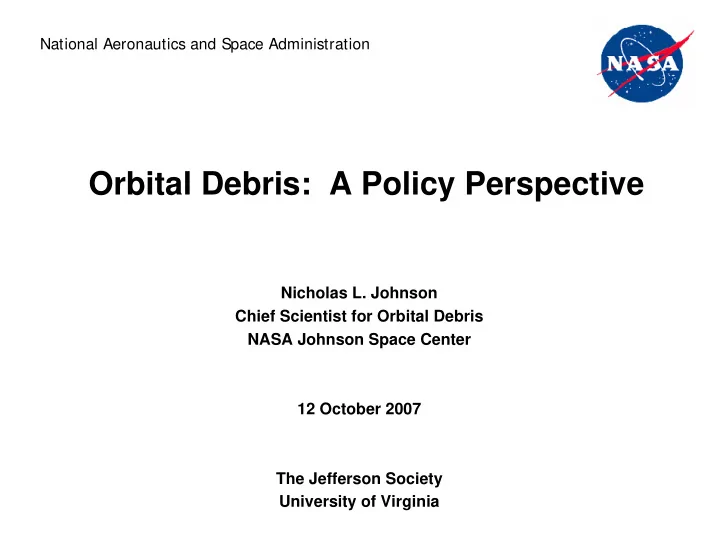

National Aeronautics and Space Administration Orbital Debris: A Policy Perspective Nicholas L. Johnson Chief Scientist for Orbital Debris NASA Johnson Space Center 12 October 2007 The Jefferson Society University of Virginia
2 Voyage through near-Earth Space National Aeronautics and Space Administration (Animation)
3 National Aeronautics and Space Administration What is Orbital Debris? Space debris encompasses both natural (meteoroid) and artificial • (man-made) particles. – Meteoroids are in orbit about the Sun – Orbital debris are man-made and in orbit about the Earth Non-operational Spacecraft Fragmentation and Mission-related Debris Derelict Launch Vehicle Stages
4 National Aeronautics and Space Administration Orbital Debris Detectors and Damage Potential Potential Shuttle Damage 6.5 Window Replacement EVA Suit Penetration 5.5 Radiator Penetration RCC Penetration 4.5 TPS Tile Penetration Cabin Penetration 3.5 Cargo Bay Damage Goldstone Radars Space Surveillance Network 2.5 Haystack Auxiliary Radar Spacecraft Surface 1.5 Inspections Haystack Radar 0.5 0.001 0.01 0.1 1 10 100 1000 Debris Diameter in Centimeters
5 National Aeronautics and Space Administration Hubble Space Telescope • The Hubble Space Telescope suffered a significant impact in one high gain antenna during its first four years in space.
6 National Aeronautics and Space Administration Hubble Space Telescope (continued) After 7 years in space the Hubble Space Telescope had been peppered with more than 500 craters on its aft shroud.
7 National Aeronautics and Space Administration Mir Space Station Solar Array • Sample impact from Mir solar array returned in 1998 by Space Shuttle. Rear of Panel Front of Panel
8 National Aeronautics and Space Administration International Space Station
9 Space Shuttle National Aeronautics and Space Administration
10 National Aeronautics and Space Administration Satellite Explosions Nearly 200 satellite breakups identified since 1961 • – Primary source of orbital debris larger than 1 cm Explosion of Russian Launch Vehicle Stage in February 2007
11 National Aeronautics and Space Administration Satellite Collisions • Three accidental satellite collisions from different missions have already been identified. • In the future, accidental collisions among derelict objects will be the greatest source of new debris.
12 National Aeronautics and Space Administration NASA Orbital Debris Mitigation Guidelines • Avoid the unnecessary release of orbital debris • Avoid accidental and deliberate satellite fragmentations • Properly dispose of spacecraft and launch vehicle orbital stages • Protect people and property on Earth from reentering debris
13 National Aeronautics and Space Administration International Space Station Jettison Policy SUITSAT
14 National Aeronautics and Space Administration International Space Station Jettison Policy (Video)
15 National Aeronautics and Space Administration Controlled Satellite Reentries Reentry 2000 Compton Gamma Ray Observatory
16 National Aeronautics and Space Administration Controlled Satellite Reentries Mir Space Station Reentry 2001
17 National Aeronautics and Space Administration Uncontrolled Satellite Reentries • Georgetown, Texas, 1997
18 National Aeronautics and Space Administration Return of Space Objects • Nose cone launched in October 1998 • Washed ashore in Texas in Feb 2000 • Returned to France in 2004
19 National Aeronautics and Space Administration Orbital Debris and U.S. National Space Policy • Orbital debris has been addressed in all U.S. national space policies since 1988. • New National Space Policy (signed 31 August 2006 by President Bush) states: “Orbital debris poses a risk to continued reliable use of space-based services and operations and to the safety of persons and property in space and on Earth. The United States shall seek to minimize the creation of orbital debris by government and non-government operations in space in order to preserve the space environment for future generations.”
20 National Aeronautics and Space Administration U.S Government Policy Strategy
21 National Aeronautics and Space Administration Bankruptcy of the Iridium Satellite System
22 National Aeronautics and Space Administration Inter-Agency Space Debris Coordination Committee (IADC) Italy France United Kingdom China European Space Agency Germany India Japan Ukraine US Russia
23 National Aeronautics and Space Administration Orbital Debris at the United Nations
24 National Aeronautics and Space Administration Chinese Anti-satellite System (Animation) • Test conducted 11 Jan 2007 • ~2500 large orbital debris • Some debris will remain in orbit for > 100 years
25 National Aeronautics and Space Administration Future Evolution of Satellite Population • In the future accidental collisions will dominate the growth of debris population. 12000 Total Intacts + mission related debris Effective Number of Objects (>10cm, LEO) 10000 Explosion fragments Collision fragments No new 8000 launch scenario 6000 4000 2000 0 1950 1970 1990 2010 2030 2050 2070 2090 2110 2130 2150 2170 2190 2210 Year
26 National Aeronautics and Space Administration Challenge of Orbital Debris Failure to curtail the growth of orbital debris will eventually lead to • potential loss or limitation of the practical use of portions of near- Earth space for economic, scientific, and national security purposes. • The challenge of orbital debris is to identify economically acceptable, but effective, mitigation practices which will be implemented by the majority of international space-faring community. – The alternative is to bequeath a degraded space environment to future generations
Recommend
More recommend